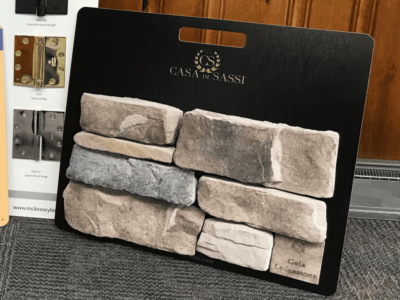Creating impactful sample boards is essential for professionals in the home improvement industry, including designers, architects, and contractors. Sample display boards serve as a visual representation of ideas and materials, helping clients visualize their projects. This guide explores the purpose of sample boards, key elements to include, material selection, color theory, storytelling, organization tips, design techniques, and more. By following these guidelines, you can create sample display boards that captivate and engage your clients.
As a designer with over a decade of experience in creating sample boards for tile and other materials, I have found that a well-crafted sample board can transform the client experience and streamline the decision-making process.
Understanding the Purpose of Sample Boards in Home Improvement
What Are Sample Boards?
Sample boards for tile are physical or digital displays that showcase a selection of materials, colors, and finishes for a design project. They provide a tangible way for clients to see and feel the elements that will be part of their home improvement project. Whether you’re working on a kitchen remodel, bathroom renovation, or flooring project, sample boards play a crucial role in decision-making.
Why Are Sample Boards Important?
Visual Communication: Sample boards bridge the gap between your ideas and the client’s vision. They allow clients to visualize how different elements work together in a cohesive design.
Decision-Making: When clients can see and touch the materials, they are more likely to make informed decisions, reducing the risk of costly changes later.
Inspiration: A well-designed sample board can inspire clients, sparking ideas and encouraging them to explore different design possibilities.
The Role of Sample Boards in Client Relationships
Sample boards build trust and transparency between you and your clients. By clearly presenting materials and design choices, you demonstrate professionalism and commitment to their project. This fosters confidence and ensures that clients feel involved in the process.

Key Elements to Include in Your Sample Board
Creating an effective sample board requires careful consideration of various elements. Here are some key components to include:
Materials
Include a variety of materials relevant to the project. For a kitchen design, showcase samples of countertops, cabinetry, backsplash tiles, and flooring. When presenting sample boards for tile, ensure you include different sizes, finishes, and textures.
Color Palette
Present a cohesive color palette that complements the materials. Use paint swatches, fabric samples, or digital color blocks to illustrate the intended color scheme.
Textures
Incorporate different textures to give clients a tactile experience. This could include fabric swatches, wood samples, or photographs of textured finishes.
Layouts and Configurations
If applicable, include layout sketches or diagrams to demonstrate how the materials will be used in the space. This helps clients visualize the end result more effectively.
Visual Aids
Use images of completed projects or mood boards to enhance your sample board. This provides context and shows clients the potential outcome of their design choices.
Choosing the Right Materials for Maximum Impact
Importance of Material Selection
The materials you choose for your sample boards can significantly impact the overall impression of your design. High-quality materials not only look better but also convey a sense of craftsmanship and attention to detail.
Factors to Consider
Durability: Choose materials that are not only aesthetically pleasing but also durable and suitable for the intended space. For example, tiles used in bathrooms should be waterproof and slip-resistant.
Sustainability: More clients are prioritizing eco-friendly options. Consider incorporating sustainable materials into your sample boards to appeal to environmentally conscious clients.
Cost: While high-quality materials are important, balance quality with cost. Present a range of options to accommodate different budgets.
Sourcing Materials
Develop relationships with local suppliers and manufacturers. This ensures you have access to a variety of materials for your sample boards and helps you stay updated on the latest trends.
Color Theory: Selecting a Cohesive Palette for Your Boards
Understanding Color Theory
Color theory is a fundamental aspect of design that can significantly influence the mood and aesthetic of a space. Understanding how colors interact helps you create a visually appealing sample board.
Choosing a Color Palette
Complementary Colors: Select colors that complement each other to create harmony within the design. Pair warm tones with cool tones for balance.
Monochromatic Schemes: Using different shades of a single color creates a sophisticated and cohesive appearance.
Contrasting Colors: Use contrasting colors to create visual interest, but do so sparingly to avoid overwhelming the viewer.
Testing Your Palette
Before finalizing your color palette, test it by creating small mock-ups or digital renderings. This allows you to see how the colors work together in different lighting conditions.
Creating a Narrative: Telling a Story with Your Sample Board
The Power of Storytelling in Design
Every home improvement project has a story, and your sample board should reflect that narrative. By telling a story, you can engage clients emotionally and make the design more relatable.
How to Craft a Narrative
Identify Key Themes: Determine the central themes of the project. Is it modern, rustic, or coastal? Use these themes to guide your material and color choices.
Client Preferences: Incorporate elements that reflect the client’s personality and lifestyle. This could include favorite colors, hobbies, or specific design inspirations.
Visual Flow: Arrange the elements on your sample board to guide the viewer’s eye through the narrative. Start with the foundation (like flooring) and build up to accents (like decorative tiles).
Examples of Effective Narratives
Modern Minimalism: For a modern home, use sleek materials and a monochromatic color palette to convey simplicity and elegance.
Coastal Retreat: Incorporate soft blues, sandy textures, and light woods to evoke a relaxed coastal vibe.
Tips for Organizing Samples Effectively
The Importance of Organization
An organized sample board looks professional and makes it easier for clients to understand the design concept. Chaos can lead to confusion and miscommunication.
Organizational Strategies
Categorize by Material Type: Group similar materials together. For example, keep all tile samples in one section and paint colors in another.
Use Labels: Clearly label each sample with the name, manufacturer, and any relevant details, such as dimensions or finishes.
Visual Hierarchy: Create a clear visual hierarchy by placing the most important samples at eye level. This draws attention to key elements of the design.
Digital Organization
If creating a digital sample board, use organized folders and clear file names for easy access.
Design Techniques to Elevate Your Sample Presentation
Presentation Matters
The way you present your sample board affects client perception. A well-designed presentation elevates your work and makes a lasting impression.
Design Techniques to Consider
Balance and Symmetry: Strive for a balanced layout. Symmetry creates order and professionalism.
Use of Space: Ensure enough white space around samples to prevent overcrowding, allowing each element to stand out.
Incorporate Visuals: Use high-quality images and graphics to support your samples, including inspiration images or design sketches.
Interactive Elements: Consider adding interactive features, such as swatch pull-outs or digital tools that allow clients to mix and match.
Final Touches
Before presenting your sample board, review it for inconsistencies or clutter. A polished final product leaves a positive impression.
Digital vs. Physical Sample Boards: Pros and Cons
The Debate: Digital vs. Physical
As technology evolves, many professionals explore the benefits of digital sample boards alongside traditional physical ones. Each option has pros and cons.
Physical Sample Boards
Pros:
– Tactile Experience: Clients can touch and feel materials, creating a deeper connection to the design.
– Immediate Impact: A well-crafted physical board creates a strong first impression.
Cons:
– Logistics: Transporting and setting up physical boards can be cumbersome.
– Limited Scope: It can be challenging to showcase a wide variety of options.
Digital Sample Boards
Pros:
– Versatility: Digital boards can include a broader range of materials without physical limitations.
– Easy Sharing: They can be easily shared with clients via email or presentations.
Cons:
– Lack of Tangibility: Clients miss the tactile experience, making it harder to connect with materials.
– Technical Issues: Potential technology or software issues can disrupt presentations.
Making the Choice
Ultimately, the choice between digital and physical sample boards depends on your client’s preferences and the project nature. Consider using a combination of both for a comprehensive experience.
Featured client/products:
Glass Floors | Semi Truck Ramp | Glass Blocks| SEO Services Near Me | Steel Yard Ramp | Ramp for Loading Dock | Glass Flooring | Loading Dock Ramps | Portable Yard Ramp | SEO Company Near Me | SEO Agency Akron | SEO Expert Near Me | Marketing Agencies Near Me | Marketing Agency Akron
Yard Ramps | Yard Ramp




